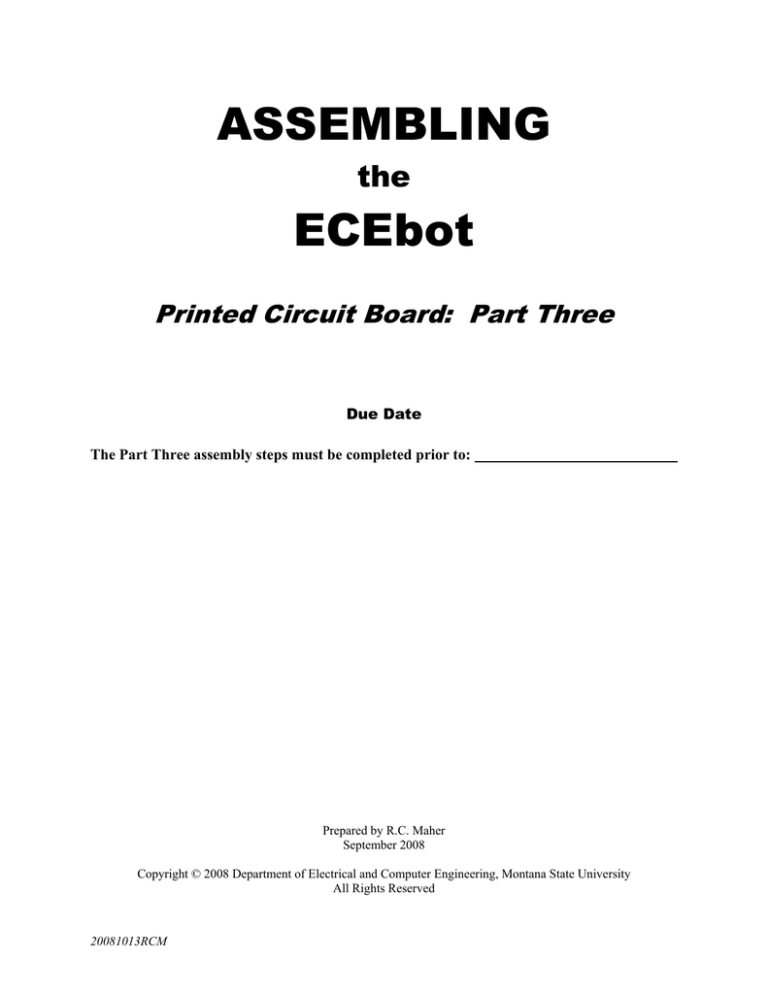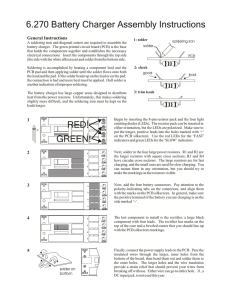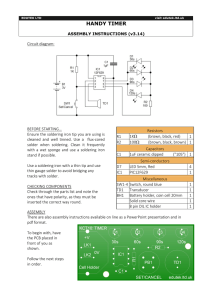
ASSEMBLING
the
ECEbot
Printed Circuit Board: Part Three
Due Date
The Part Three assembly steps must be completed prior to:
Prepared by R.C. Maher
September 2008
Copyright © 2008 Department of Electrical and Computer Engineering, Montana State University
All Rights Reserved
20081013RCM
PCB Assembly
3.1.
3.1.1.
Part Three
2
Soldering Step 8: Light Emitting Diodes
Display
Figure 3-1 shows the location of the 4-digit LED Display (U1) to be mounted at the top
center of the PCB.
4-digit Display
(decimal points: lower right)
Figure 3-1: Position of 4-digit LED Display
First, take the 4-digit display and insert its 12 pins with the same orientation as the silk
screen: decimal points located to the bottom right of each digit.
→ As before, use a piece of tape or some other technique to keep the display flush with the
PCB while soldering the display's pins on the back side.
3.1.2.
Discrete LEDs
Four individual light emitting diodes need to be installed (LED2, LED3, LED4 and LED5).
Remember: The LEDs (light emitting diodes) are directional. The long wire is the anode and the short wire
is the cathode. Make sure the LED is inserted so the short wire goes through the square pad
anode: long wire
cathode: short wire
Short wire…
…square pad
PCB Assembly
Part Three
3
Figure 3-2: Discrete LED Position and Orientation
→ Solder each LED in place and carefully snip the excess wire.
3.2.
3.2.1.
Soldering Step 9: DIP Switches and Decoder Chips
DIP Switches
→ Next, solder in place the 16 pins of the DIP switch (S1), making sure that
the switch numbers and ‘ON’ label read right-side up before you start soldering.
By now you are probably getting pretty comfortable soldering, but be sure to
only use just enough heat and time to make good joints: overheating can cause
damage to the components.
O1 2 3 4 5 6 7 8
N
PCB Assembly
3.2.2.
Part Three
4
Decoder Integrated Circuits
The final electronic components are two integrated circuit (IC)
packages. These are black, 16-pin, dual in-line packages. Although the
two packages are exactly the same shape and size, notice that they are
labeled with different part numbers and they perform two different
functions. They must be installed in the proper place. IT MATTERS
WHICH CIRCUIT GOES WHERE, SO DOUBLE-CHECK YOUR
IDENTIFICATION AND PACKAGE ORIENTATION!!
74LS47
74LS138
Hint: The integrated circuits can be damaged easily by static electricity and overheating during
soldering. It is possible for a static discharge to occur even if you don’t feel or see a spark! Be sure to
discharge yourself frequently when working at the lab bench by touching a grounded panel or chassis. If
possible, use an approved grounding wrist strap and antistatic mat.
→ The device placed in location U8 (left spot) is the 74LS47 (“BCD to 7-segment decoder”).
Turn the device so that the notch on the package is to the left, and gently insert through the holes.
Keep the package flush with the board while you solder the pins on the back side. Don’t
overheat the pins!
→ The device placed in location U6 (right spot) is the 74LS138 (“1-of-8 decoder”). Orient
the package so the notch is on the left, and hold the package flush with the board while you
solder the pins on the back side.
74LS47
74LS138
Figure 3-3: Placement of the Decoder ICs. Double check the IC label and mounting position!
PCB Assembly
3.3.
Part Three
Soldering Step 10: Bumper Switch Connectors
The last soldering step is to attach the two edge connectors for the bumper switches.
→ Locate the 4-pin edge connector and solder it in place on the top left front of the board
(J6), and locate the 6-pin edge connector and solder it in place on the top right front (J8).
Figure 3-4: 4-pin and 6-pin edge connectors (for bumper switch attachment).
3.4.
Final PCB Visual Inspection
Take a moment to examine the board carefully and critically.
Are there any missing components—other than the unused areas of the board?
Are all the pins soldered completely?
Are there any "whiskers" or "solder bridges" between the pads?
Is there any loose debris (like solder crumbs or metal flakes) caught anywhere on the
board? Look closely.
Do you see any damage to the board or its components, like bent pins, cracked
housings, or crushed LEDs?
Be sure to ask your instructor or lab TA to examine any questionable areas of your PCB.
You will perform electrical tests during the next lab session.
You must complete the entire PCB assembly to this point by the due date.
5




